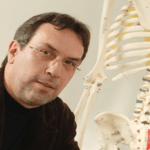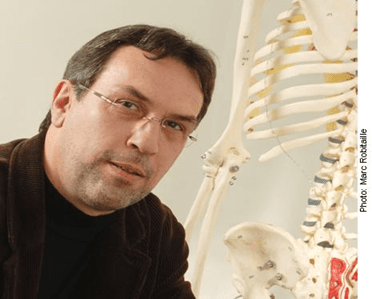Pain is not a big killer like cancer or infectious diseases. However, back pain tops the scales of disease burden: when comorbidity is considered with disability-adjusted life years (DALYs)*– then back pain wins in almost every country (see http://www.healthdata.org/gbd). Other musculoskeletal problems, including arthritis, also count among the health conditions with the largest burden, as measured with DALYs. And the burden associated with these problems has increased over the years. This seems odd – despite progress in research, improvements in living and work conditions, and improved clinical knowledge in many disciplines, back and other musculoskeletal pain are still extremely frequent and continue to represent a real enigma.
Could it be that we haven’t yet found the actual source of back pain, or some of its important determinants? Although our knowledge of back pain now includes physical/biological, psychological and social determinants, we still need new ideas. But we seem to have explored everything…
In response to the bio-psycho-social model of back pain, much research has focused on the psycho-social components. Our team wanted to innovate by looking at some biological variables that haven’t previously been looked at seriously. We thought that:
1) Because back pain very often comes with musculoskeletal pain in other anatomical sites, it would make sense if some of its determinants would be systemic instead of regional;
2) Vitamin C is an essential element for the health of collagen, the main ingredient of ligaments, tendons and bones;
3) There is strong evidence that smokers have more back pain, but this relationship has not yet been explained;
4) Recent evidence showed that smokers need to ingest much more vitamin C than non-smokers to achieve the recommended blood levels;
5) Limited evidence indicates that daily administration of high doses of vitamin C in wrist, foot and ankle surgery or injury may help avoid complex regional pain syndrome,[1] supporting an important role of vitamin C in tissue repair and pain.
All this brought us to hypothesize that the reason for smokers having more back pain could be because they would be in a state of hypovitaminosis C (a subclinical deficit in vitamin C) more often than non-smokers. This would also explain the ‘systemic’ nature of musculoskeletal pain.
One could say that we know everything about vitamin C and that if our hypothesis were true, it would be already known. Actually, things are not that simple, mostly because vitamin C is a moving target: since it is not stored in the body (it is excreted in urine), we need to ingest it every day (in fruits and vegetables or supplements). Measuring it is therefore complicated. What we know is that a severe deficiency in vitamin C causes scurvy, a painful and deadly disease that decimated many explorers of the New World until the native people showed Europeans how to get vitamin C from birch bark. The Recommended Daily Allowances (RDA) of vitamin C are essentially based on twice the amount necessary to prevent scurvy.[2, 3] Although scurvy is now rare, it still exists: several cases were recently diagnosed in Australia. But of more concern is hypovitaminosis C, which is frequent in adults of the general population.[4] What if some musculoskeletal pain is caused by lack of vitamin C?
To test this hypothesis, we conducted a secondary analysis of data from the United States’s National Health and Nutrition Examination Survey (NHANES). These data are especially interesting not only because they document several health problems (including back pain), but also because each participant was seen face-to-face by an interviewer and contributed a blood sample. This allowed precise measurement of their serum concentrations of vitamin C. We were thus able to assess if there is a statistical relationship between serum concentrations of vitamin C and several measures of spinal pain (neck pain, low back pain, low back pain with pain below the knee, arthritis/rheumatism and related functional limitations). We found significant associations for all pertinent outcomes, the strength of which tended to decrease with increasing serum concentrations of vitamin C. These results took into account several other variables (sex, age, obesity, education, comorbidities, family income, vitamin D, physical demands of usual daily activities, physical leisure activity, psychological distress, daily energy intake, smoking status and supplementation of vitamin C).[5]
Because they come from an observational study, these results are not a definitive answer to the question of whether vitamin C levels are a determinant of spinal pain. However, they call for randomized controlled trials of vitamin C as a potential means to prevent or treat spinal pain. If cheap and safe supplementation of vitamin C could successfully prevent or treat some cases of back pain, this knowledge could have a very important impact on the health of populations.
*Disability-adjusted life years (DALYs) is a measure of overall disease burden expressed as the number of years lost due to ill-health, disability or early death.
About Clermont E. Dionne
 Clermont E. Dionne (Ph.D. in Epidemiology, University of Washington, USA), is a senior investigator at the Research Centre of the Laval University Hospital (Population Health and Optimal Health Practices Axis) and Full Professor in the Department of Rehabilitation, Faculty of Medicine, Université Laval, Quebec City, Canada. He works since more than 20 years on the epidemiology of musculoskeletal pain, including etiological and prognostic research, and the development of clinical decision rules. He has been involved in many national and international committees and acts regularly as a reviewer for many scientific journals and granting agencies.
Clermont E. Dionne (Ph.D. in Epidemiology, University of Washington, USA), is a senior investigator at the Research Centre of the Laval University Hospital (Population Health and Optimal Health Practices Axis) and Full Professor in the Department of Rehabilitation, Faculty of Medicine, Université Laval, Quebec City, Canada. He works since more than 20 years on the epidemiology of musculoskeletal pain, including etiological and prognostic research, and the development of clinical decision rules. He has been involved in many national and international committees and acts regularly as a reviewer for many scientific journals and granting agencies.
References
[1] Chen S, Roffey DM, Dion CA, Arab A, Wai EK. Effect of perioperative vitamin C supplementation on postoperative pain and the incidence of chronic regional pain syndrome: A systematic review and meta-analysis. Clin J Pain. 2016; 32(2):179-85.
[2] Lykkesfeldt J, Poulsen HE. Is vitamin C supplementation beneficial? Lessons learned from randomised controlled trials. Br J Nutr. 2010;103(9):1251-9.
[3] Deruelle F, Baron B. Vitamin C: Is supplementation necessary for optimal health? J Altern Complement Med 2008;14(10):1291-8.
[4] Cahill L, Corey PN, El-Sohemy A. Vitamin C deficiency in a population of young Canadian adults. Am J Epidemiol. 2009;170(4):464-71.
[5] Dionne CE, Laurin D, Desrosiers T, Abdous B, Le Sage N, Frenette J, et al. Serum vitamin C and spinal pain: a nationwide study. Pain. 2016;157(11):2527-35.
Commissioning Editors: Lorimer Moseley and Neil O’Connell; Associate Editor: Tory Madden



